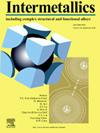V含量通过晶格间距、晶粒尺寸和位错协同作用调节Ti2Zr0.75NbVx中熵合金的塑性变形
IF 4.3
2区 材料科学
Q2 CHEMISTRY, PHYSICAL
引用次数: 0
摘要
采用真空电弧熔炼法制备了Ti2Zr0.75NbVx (x = 0.25, 0.5, 0.75, 1)轻量化中熵合金(LMEAs),系统研究了V含量对合金组织和力学性能的影响。结果表明:随着V含量的增加,晶体的晶格间距和晶粒尺寸逐渐减小,位错密度和取向明显增强;其中,晶格间距和晶粒尺寸最小(191.105 μm)的V1合金塑性最高,伸长率为16.8%。分子动力学模拟进一步表明,晶格间距较小的合金具有较低的位错形成能,从而显著促进位错成核和滑移,从而提高塑性变形能力。高密度平行位错束的形成优化了应力分布,延缓了局部应力集中和裂纹萌生,进一步提高了合金的塑性。这些发现为高性能轻质合金的设计提供了重要的理论见解,并为开发具有高强度和高延展性的新型合金材料奠定了基础。本文章由计算机程序翻译,如有差异,请以英文原文为准。

V content modulates plastic deformation in Ti2Zr0.75NbVx medium-entropy alloys via lattice spacing, grain size, and dislocation synergy
In this study, Ti2Zr0.75NbVx (x = 0.25, 0.5, 0.75, 1) lightweight medium-entropy alloys (LMEAs) were prepared via vacuum arc melting, and the influence of V content on the microstructure and mechanical properties was systematically investigated. The results show that with increasing V content, the lattice spacing and grain size gradually decrease, while the dislocation density and alignment are significantly enhanced. Among them, the V1 alloy, with the smallest lattice spacing and grain size (191.105 μm), exhibits the highest plasticity (16.8 % elongation). Molecular dynamics simulations further reveal that alloys with smaller lattice spacing possess lower dislocation formation energy, which significantly promotes dislocation nucleation and slip, thereby enhancing plastic deformation capability. Additionally, the formation of high-density parallel dislocation bundles optimizes stress distribution, delays local stress concentration and crack initiation, and further improves the alloy's plasticity. These findings provide critical theoretical insights for the design of high-performance lightweight alloys and lay a foundation for developing novel alloy materials with both high strength and high ductility.
求助全文
通过发布文献求助,成功后即可免费获取论文全文。
去求助
来源期刊

Intermetallics
工程技术-材料科学:综合
CiteScore
7.80
自引率
9.10%
发文量
291
审稿时长
37 days
期刊介绍:
This journal is a platform for publishing innovative research and overviews for advancing our understanding of the structure, property, and functionality of complex metallic alloys, including intermetallics, metallic glasses, and high entropy alloys.
The journal reports the science and engineering of metallic materials in the following aspects:
Theories and experiments which address the relationship between property and structure in all length scales.
Physical modeling and numerical simulations which provide a comprehensive understanding of experimental observations.
Stimulated methodologies to characterize the structure and chemistry of materials that correlate the properties.
Technological applications resulting from the understanding of property-structure relationship in materials.
Novel and cutting-edge results warranting rapid communication.
The journal also publishes special issues on selected topics and overviews by invitation only.
 求助内容:
求助内容: 应助结果提醒方式:
应助结果提醒方式:


